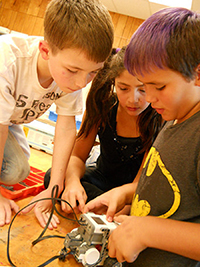
OSU Open Campus, a pioneering program begun just five years ago by Oregon State University to better serve the diverse educational needs of the state, has expanded rapidly, kept students in school, put people to work and is addressing the needs of many Oregon communities.
For its innovations and success, the program was just recognized as one of four national winners of the Outreach Scholarship W.K. Kellogg Foundation Engagement Award. It will also compete for the C. Peter Magrath University Community Engagement Award, the top honor nationally for this type of initiative.
OSU Open Campus, at its inception, recognized that education costs were increasing, many smaller or remote communities required programs tailored to their needs, and that only a broad coalition of K-12 schools, community colleges, local governments and businesses could hope to address that challenge.
A collaborative effort of the OSU Extension Service and OSU Extended Campus helped to create that coalition, and the results have been extraordinary for Tillamook, Hood River, Madras, Prineville, Klamath Falls and Coos Bay.
“OSU Open Campus expands the university’s commitment to the people of Oregon,” said OSU President Ed Ray. “In six communities throughout the state, progress is being made in college attainment, economic development, and successful partnerships to encourage a seamless transition into and through the educational pipeline.”
Along with other aspects of recent OSU expansion and leadership, OSU Open Campus is helping entire communities to support the statewide goal of “40-40-20,” which requires that by 2025 40 percent of adults have an undergraduate degree, 40 percent an associate’s degree or certificate, and 20 percent a high school diploma.
The program is fast and flexible. It cuts bureaucratic red tape, taps into local community needs and tries to provide the type of education needed at costs that local residents can afford. Sometimes that will result in students who progress all the way to a bachelor’s degree. Other times, the goals are more immediate.
In Jefferson County, a small business owner faced closure due to a lack of qualified welders in the area. OSU Open Campus coordinated a plan, beginning with a local high school offering use of an unused welding lab for an eight-week course. Central Oregon Community College provided an instructor, and a local charity provided funds for equipment and gear. The course ultimately had 17 participants, including eight high school students and nine unemployed or under-employed adults.
As a result, all the adults now have good-paying jobs as welders, two small businesses were saved, and one participant finished his GED and is enrolled at Central Oregon Community College.
If a person’s ultimate goal is a full college education, OSU Open Campus can help with that, too.
“Some students are place-bound for a number of reasons,” said program director Jeff Sherman. “They can’t afford the costs of living on a campus, or have family responsibilities and employment that make moving impossible.”
One analysis in Klamath County concluded that, through an Open Campus collaboration of local high schools, Klamath Community College and OSU Ecampus, degrees in high local demand such as agricultural sciences or natural resources could be obtained for less than half the cost of attending OSU’s main campus, without ever having to leave the county.
Among the growth trends and accomplishments of the program:
• OSU Open Campus is now serving six communities in nine rural counties, and the number of learners has more than doubled since its inception.
• Initiatives include precollege programs at local K-12 schools, small business development workshops, parent education and academic support for Latino students, community literacy projects and youth entrepreneurship courses.
• The “Juntos” program for Latino students has dramatically increased their graduation rates at Madras High School and within the next year the first cohort from that program will be starting college.
• In the Columbia Gorge, collaboration with a local OSU 4-H program is involving 1,640 students a year in science, technology, engineering and math programs, and regularly win robotic competitions at all grade levels.
• OSU Ecampus sees OSU Open Campus as its key partner for student retention and degree completion in Oregon.
In the future, Oregon State hopes to further expand the number of its faculty who work at OSU Open Campus sites, bring community teams to the university campus for recognition, and take other steps to grow the program.
“OSU Open Campus is a concept, not a place,” said Scott Reed, Oregon State Vice Provost for University Outreach and Engagement. “It’s helping all of our internal and external partners to change and adapt. We’re empowering communities, crossing traditional boundaries, and in the process, the university gets better.”
OSU is one of only two universities in the United States that is designated a Land Grant, Sea Grant, Space Grant and Sun Grant institution. OSU is also Oregon’s only university to hold both the Carnegie Foundation’s top designation for research institutions and its prestigious Community Engagement classification.



